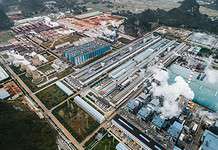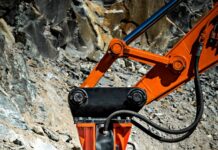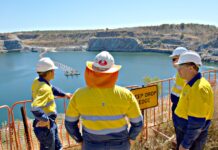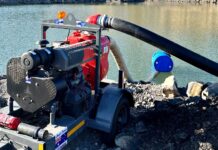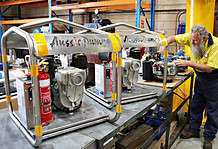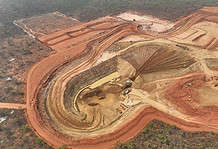All images: Southern Ports Authority.
By Elizabeth Fabri
WHEN multiple entities join forces to combine their expertise and knowledge great things can happen. The Southern Ports Authority, an amalgamation of the Port Authorities at Albany, Bunbury and Esperance, has propelled further production efficiencies, safety measures and annual trade of more than $15.6 billion since its formation.
The merger between the three ports kicked off in October 2014 after much deliberation by the WA Government following a comprehensive review.
The 2010 review delved into all matters concerning port operations, performance and governance to ensure all of the State’s ports were able to keep up with the demands of the rapidly growing economy.
It was decided that port infrastructure would be optimised by consolidating the three ports and having one central authority connecting southern WA to the world. There would also be reduced expenditure, improved investment decisions and corporate governance, and greater consistency of port views on regulation and safety.
The idea was for a single entity to provide and maintain the shipping channels, navigation aids, security systems, seawalls and road infrastructure, while each Port maintained different operational models that may see other common services provided, including emergency response, waste and property management, ship scheduling, berth allocation and marine pilotage.
On 20 May 2014, the legislation allowing the ports to merge was given Royal Assent, and together the three ports now shared a catchment of 400,000sqkm, 14 berths, and annual trade of about 36 million tonnes from the mining, forestry and agriculture industries.
About 780 ships visited the Southern Ports each year, including 27 cruise ships, and it directly employed 220 people and supported a staggering 12,000 trade jobs across the region.
The Port of Esperance alone is the largest nickel contrite exporting port in the southern hemisphere, and will soon become well known for exporting spodumene – a source of lithium – to Asia.
Southern Ports Authority chief executive Nicolas Fertin said out of its trade, 30 per cent was iron ore; 30 per cent was alumina, and 10 per cent of trade or close to 4mt was various other mining products such as nickel, mineral sands and spodumene..
“We’re forecasting to more than double the spodumene export,” Mr Fertin said.
“At the moment it’s a small percentage of our trade and very important for the regions, and we’re very conscious that the WA catchment area of the three ports contains some of the richest deposits in the world.”
Port performance
In FY16, Southern Ports Authority trade came to 36.1mt; a 0.2 per cent dip from the previous year.
The minor slump was attributed to a 6 per cent decrease in the Port of Albany trade (13 per cent of the Authority trade) and flat results at the Port of Bunbury, which was offset by a 1 per cent increase in trade at the Port of Esperance (42 per cent of Authority trade).
Yet despite the shortfall, the Authority remained confident on its performance across the three operations.
“The Authority has again had a successful year and has returned a solid profit result, despite a challenging economic environment,” Southern Ports Authority chairman Robert Cole said in the company’s 2016 annual report.
“Total trade has remained largely in line with FY15, with a decline in revenue offset by a greater decline in operating costs, resulting in a modest improvement in profit on a full financial year comparative basis.
“In the past year, the Authority has continued to make strong progress on all aspects of the integration of its three Ports including improved commercial arrangements with customers, developing new trade and business opportunities and planning for future facilities and infrastructure.”
In FY16 total revenue per tonne reduced by 3.9 per cent and total cost per tonne reduced by 6.9 per cent on a full financial year comparative basis.
The Authority also introduced a new Chart of Accounts to allow for automatic consolidation, enhanced IT architecture to boost communication, and an enhanced employment framework to reduce costs, improve the supply chain and increase safety and security.
“We’ve also been able to deliver $2 million savings that’s going to be shared across port users for Esperance and Bunbury,” Mr Fertin said.
“I’m very confident in the savings that we have delivered internally in the business and confident in the future that we will continue to deliver efficiency and that’s been reflected by the lowest price increase for our services for the next financial year will be 0.5 per cent, which is the lowest ever in the last five years.”
At the Port of Esperance, the loading rate had improved by up to 20 per cent over the last three years, and Stage 1 of its access road upgrade and the enclosure of its last transfer tower had been completed.
In fiscal 2016, about 94 per cent of the Port of Esperance’s tonnage was made up of iron ore, nickel and grain exports, while the remaining 6 per cent consisted of the import of sulphur, petroleum products and fertiliser.
At the beginning of January, Galaxy Resources exported spodumene from its recommissioned Mt Cattlin project, which marked the first time spodumene was exported through the Port of Esperance.
“The first shipment trial, where typically customers are sending a sample or finalising the factories overseas, was done between Christmas and New Year, and the first official shipment, which will be followed by monthly shipments would be at the end of March,” Mr Fertin said.
“We’re very optimistic with that; we are using sheds that have been unused since 2009 and we’re using new technology.”
Further west in Bunbury, Southern Ports completed Berth 3 anchor repairs, and conducted a trial export of 22,075t of leucoxene.
Alumina exports were stable with a total throughput of 10.7mt, accounting for 66 per cent of total port trade.
However, the Port of Albany trade was predominately made up of grain (60.3 per cent), and woodchips (30.9 per cent), and the recently returned log trade.

Commitment to safety
One of the most notable achievements over the last 12 months was Southern Ports’ reduction of lost time injury frequency rate from 22.6 in July 2015 to zero in June 2016.
“We’ve been able to divide the number of injuries by three and then eliminate all the LTI within the first year of the amalgamation,” Mr Fertin said, attributing the success to a combination of factors.
“The first one is all the executives and myself are directly walking the talk and we’re actually onsite on a regular basis,” he said.
“We are showing our interest on safety and are ensuring people are talking about their safety.
“We’re improving also the way that they operate; we have had a lot of initiatives to make staff talk about the things that they do every day that can make them safer.”
The ports had also introduced a number of innovations that improved safety, including new technologies for loading freights into vessels.
Mr Fertin said the fact that they had no lost time injuries for several months was a “good result”, but Southern Ports still had to continue its efforts.
“On safety, you are never finishing your journey,” he said.
“We still have incidents and near misses that we continue to investigate so it’s a never ending journey to make sure that the place is safe every day.”
2017 outlook
With just a few months left to end of financial year, Mr Fertin said the ports were on track to achieve roughly the same tonnage as the previous fiscal period.
“We’re also on track to achieve our key performance indicator for the financial year which is the rate of return. Our target is to achieve 9.7 per cent and we’re very confident to achieve that,” Mr Fertin said.
He said over the next 12 months, Southern Ports would focus primarily on its channels and road and rail access.
“We believe it’s very important we have that well maintained and available so there’s quite a bit of investments we’re doing in that space, and because of the new executives we’ve been able to recruit, we’ve been doing a lot of work in planning for larger expansions in a progressive way,” he said.
“I’m quite optimistic that 2017 will continue to see the growth in some of the mining commodities but Southern Ports is also diversified and good growth out of wood chips and grain which gives us a diversification and more resilience.”
Southern Ports was also working to explore the opportunity for exporting bauxite out of Bunbury in the future, and Mr Fertin said it would continue to be on the pulse of global mining activity to ensure it was ready to take on added export capacity when the market required.
“I think that it’s a very volatile time at the moment,” Mr Fertin said.
“Some of the commodity pricesin the past 18 months or two years have been divided by three or four, and some of them have been multiplied also during that time.
“I think that creates two things from a port’s perspective; the first one is that we need to continue to reduce our costs wherever we can and the amalgamation is a great mechanism that allows us to do that.”




